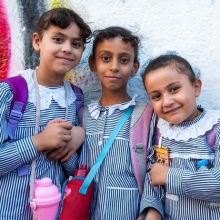Current crises are increasing migration pressures with complex regional and strategic implications. According to the World Development Report 2023, 184 million people were on the move as migrants around the world, driven by economic opportunities, conflict and violence, or other reasons. About half live in high-income countries, and one-third live in developing countries. Many countries at all income levels are both origin, transit, and destination countries at the same time.
There is increasing demand for World Bank support at the country and global level to help with the orderly migration and protection of migrants. Addressing the underlying drivers of migration is key to leveraging the movement of people for economic growth and poverty alleviation. At the same time, migration has already had an important development impact at both origin and destination countries through remittances, innovation and diaspora financing.
Main drivers of migration
Income gaps across countries are a powerful driver of migration. Large income gaps persist between high-income and low-income countries in both low- and high-skill occupations. Widening income inequality within origin countries, especially low-income countries, is another powerful push factor. For many poor people whose labor is their only asset, migration to a richer country offers an opportunity to escape poverty. The poorest of the poor, however, tend to migrate internally, as they are unable to afford the costs associated with moving abroad.
Demographic change is increasingly shaping our future. Based on current trajectories, by 2030 the working-age populations in developing countries are projected to increase by 552 million and these nations will need to generate sufficient jobs to reach their targets for poverty reduction and growth. These projections indicate a significant increase in migration pressures in the coming decade, especially from South Asia and Sub-Saharan Africa.
At the same time, developing countries are already, or will be, experiencing faster societal aging at much lower income levels than developed countries and need to prepare for it. Timely policy action can turn global aging into a source of inclusive economic growth. It can also improve outcomes for all, e.g., through labor migration across countries at different stages of demographic transition.
Climate change is expected to exacerbate the pressure on vulnerable people to migrate. Latest model based simulations suggest that climate change may lead to decreasing crop productivity, shortages of water, and rising sea levels, which may induce as many as 216 million people to move, although most would move within their country rather than internationally.
Fragility, conflict, and violence (FCV) leads to forced displacement, which must be addressed with collective action by origin countries, host countries, and the international community. Studies by the World Bank include Forcibly Displaced, a groundbreaking report in partnership with UNHCR that analyzed data to understand the scope of the forced displacement challenge and articulated a development approach to resolving the crisis. A subsequent paper set out recommendations to further step up the Bank’s support to conflict-induced internally displaced persons (IDPs) and their hosts.
Other push and pull factors include social exclusion and discrimination; corruption; lack of education, health care, and social security; and marriage opportunities. Diaspora networks are also a driver of migration. Policy changes in both origin and destination countries can influence migration decisions and demand for migrant workers.
Sharing the gains of migration and mitigating costs
Global welfare gains from increased cross-border labor mobility could be several times larger than those from full trade liberalization. Migrants and their families tend to gain the most in terms of increases in income and better access to education and health services. However, these gains are hindered by discrimination and difficult working conditions that immigrants from low and middle-income countries face in host countries.
The report Migrants, Markets, and Mayors: Rising above the Employment Challenge in Africa’s Secondary Cities puts a spotlight on how migrants in Africa’s secondary cities fare in urban labor markets, how they affect aggregate urban productivity, and how mayors can leverage migrants’ potential to the benefit of all
Origin countries can benefit through increased remittances, investments, trade, and transfers of skill and technology, resulting in reduced poverty and unemployment. In 2023, remittance flows to low and middle-income countries reached $656 billion, surpassing foreign direct investment (FDI) and official development assistance (ODA). On the negative side, emigration of skilled workers can affect the delivery of health and education services in small economies through brain drain of essential workers, unless there is a dedicated approach to skill-up origin countries workers for the global market (ideally through a Global Skill Partnerships approach).
High-income destination countries also benefit from migration through increased supplies of labor, skills, innovation, and entrepreneurship. Migrants pay taxes and contribute to social security systems. According to one study, 83% of the native-born population in the 22 richest OECD countries have experienced a welfare gain as a result of immigration from non-OECD countries.
However, evidence on the effect of immigration on the wages of native-born workers in destination countries remains mixed: some studies indicate small negative impacts on wages of lower-skilled native-born workers, whereas others indicate positive impacts when immigrants are skilled and complement the native-born workforce.


